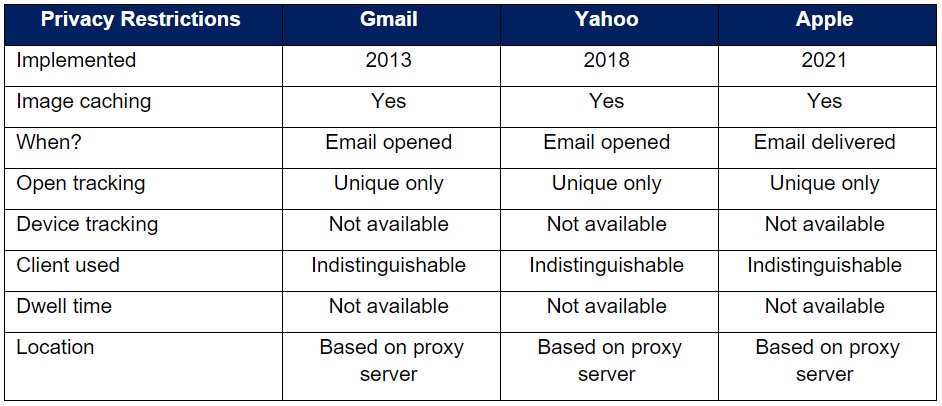
The dust is settling following Apple’s announcement in early June of plans to introduce Mail Privacy Protection (MPP) for its native Mail client users. This feature prevents email senders from using tracking pixels to measure open rates and device usage, while also masking recipients’ IP addresses to prevent location tracking.
While Apple acknowledges the impact a degraded open signal will have for legitimate purposes (e.g., activity measurement and use of live dynamic content), its customer-first philosophy means it won’t be swayed from its privacy-first position.
MPP is expected to launch in September 2021 (although it could possibly launch as late as November). There is still time to prepare, so let’s review what we’ve learned since the announcement.
It’s not entirely new.
What Apple is introducing with MPP is nothing new, with major mailbox providers (MBPs) like Gmail and Yahoo already blazing this trail. The following table summarizes their respective approaches.
Image caching means the email images (including tracking pixels) are downloaded from the original server and stored on the MBP’s proxy server(s). Subsequent views of the cached image will always load from the proxy server. For pixel tracking purposes, this means only the first download is recorded, meaning multiple interactions with an email cannot be measured.
At first glance, Apple’s plans are similar to what Gmail and Yahoo already have in place. Senders will already have an understanding of the more limited data they receive from these MBPs.
The key question is about when the caching happens. With Gmail and Yahoo, it takes place when emails are opened. Senders deploying unique tracking pixels for each subscriber (using an identifier like subscriber ID or email address) will record each subscriber’s first open, although multiple opens will not be recorded.
However, testing carried out by Validity’s engineering team using a beta version of iOS 15 shows that Apple is pre-fetching all images at the time emails are delivered (provided the devices are plugged into a power source, and connected to the internet). This means all tracking pixels will fire, irrespective of whether the actual recipient has opened the email or not. It also means the time recorded for when recipients open their emails will be inaccurate. In other words, this open signal is more degraded than the existing signals from Gmail / Yahoo and effectively devoid of value to a marketer, aside from being a broad indicator that mail was accepted for delivery.
How broad is the likely impact?
It’s important to understand the difference between MBPs and email clients. MBPs are companies that host subscribers’ mailboxes, while email clients are software applications people use to read their emails. This distinction is important because MPP is not a specific feature for iCloud mailboxes (the MBP). Rather, it is a general feature in the Mail app, which is the default client on all Apple devices (iPhones, iPads, and Macs).
For example, if you use the Apple Mail client to read emails sent to your Gmail address, any pixel-based tracking generated by those interactions will be impacted by MPP (as described above). However, if you have an Apple email address but use an Outlook account to read those emails, pixel-based tracking will not be impacted.
Data from Validity’s Everest platform shows that the most popular MBP is Gmail with ± 40% of global market share, followed by Microsoft, Yahoo, and AOL (all ± 20%, respectively). Apple only represents ± 2% of global email addresses.
However, when it comes to email client usage, Apple (iPhone & Mail) dominates with ± 50% of global market share, followed by Gmail (± 25%), Outlook (± 8%) and Yahoo Mail (± 5%). Gmail and Yahoo figures are almost certainly underreported because of image caching. Total opens are typically 1.5x greater than unique opens, so on a like-for-like, Apple’s share is probably closer to ± 40%, compared with ± 33% for Gmail.
This is important because MPP applies specifically to all users of Apple’s native Mail app. The numbers suggest significant volumes of Gmail and Microsoft emails are read in one of Apple’s email clients, meaning open rates from these subscribers will also be impacted when Apple’s changes become effective. It’s likely Apple will ship this feature as “on by default,” further amplifying the impact.
What challenges will email senders face?
Senders acknowledge that open rate has become an increasingly flawed metric. Factors like image caching and automatic enablement can create heavily skewed reporting. That said, opens have long provided the signals for established best practices like engagement-based segmentation, triggered email generation, and identification of optimal send times to name a few – and senders value the metric for this.
There is a need for email senders to become less reliant on open rate data by taking a broader view of the engagement their programs generate.
- • Senders need to acquire new subscribers who are pre-primed to engage. Subscribers themselves have a part to play. If they genuinely value their privacy, they will provide the information needed to receive relevant communications from brands they like.
- • Senders need new data points that directly connect the dots between deliverability and response, illustrating the decision process that moves subscribers from receiving an email to the start of their post-click journey.
- • Senders also need to shift their focus deeper in the conversion funnel, where the metrics provide a much stronger indication of subscriber interest and hold greater value for marketers.
How can senders address these challenges?
Let’s take a look at five approaches email senders can take to address the challenges mentioned above:
- 1. Zero means hero: Greater privacy awareness means more focus on acquiring “zero-party data.” This is data customers intentionally and proactively share, including preference center data, purchase intentions, and personal context. Senders should prioritize collection of this data by promoting their preference centers and using progressive registration/profiling tactics. Many consumers are data pragmatists, sharing personal data when there is perceived value in doing so. It’s important to clearly establish this value at sign-up, as consumers will provide higher quality personal data (including their primary email address) when this happens.
- 2. Reputation metrics: A sender’s reputation is often likened to a credit score for email marketers. It provides a view of how MBPs see their email program and whether their emails are likely to be accepted, filtered, or rejected. Most major MBPs use subscriber engagement in their spam filtering algorithms, so reputation scores provide important clues as to whether emails generate positive engagement (by getting opened and read) or negative engagement (by generating high complaint rates).
- 3. Data hygiene: Most senders use open rate data for their inactives strategies. Non-responders are either moved to a different cadence/frequency or suppressed from receiving further emails. Spam trap monitoring has a role to play – especially recycled traps which have been repurposed by MBPs for being dormant. A rise in recycled traps indicates recency management needs to be strengthened, and trap aging analysis helps measure this trend.
- 4. Inbox placement: Unlike delivered rates, which simply measure sent less bounced, there is a virtuous circle between inbox placement rates (IPRs) and open rates. Senders achieving better IPRs benefit from better open rates. However, with spam filtering increasingly informed by subscriber engagement, the reverse also holds true– great open rates mean better IPRs! This means inbox placement monitoring provides a partial proxy for open rates. When IPRs drop, diagnosis should extend to factors like changes in subject line strategy, content, and offers as possible causes.
- 5. Route to response: Metrics deeper down in the conversion funnel, such as clicks, website visits, and conversions, are still available. They provide much stronger indications of subscriber interest and are more valuable because of this. Senders should also pay far more attention to spam complaints – clicks and complaints are two sides of the same engagement coin, and both are equally important to determining the strength of the engagement signal they generate. Senders should also get these metrics into a single reporting suite, overlaying them against the deliverability data to establish full connections between cause and effect.
Conclusion
Apple’s announcement of MPP is another step in a longer journey towards greater focus on consumer privacy. Senders need to better understand what drives their subscribers to engage, be more intentional about how they acquire new subscribers, and place more focus on measuring the metrics that matter.
Validity’s Everest email success platform provides many of these crucial insights, helping senders reach more people, increase engagement, and deliver improved efficiencies for their email programs. Reach out to us today to schedule a demo.
Learn more about how consumers think about the marketing emails they receive by downloading a copy of our Consumer Email Tracker report. For further insights into the most important email metrics and how to use them, our Guide to Email Marketing Metrics is also essential reading.
